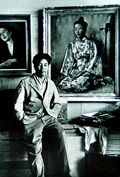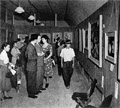|
Shift from Modernism to Avant-garde |
||
| Under San Francisco Peace Treaty, signed in 1952, Okinawa was
separated administratively from the Japanese territory. Okinawa was placed
under complete control of U.S. Military Government. During the period the
U.S. Military Government enforced expropriation of land, which triggered island
wide land struggle. In art scene, pro-modernism movement was born in some groups of artists. In 1960's, Okinawan Reversion Movement expanded and reached a peak. Such a movement also influenced greatly on art scene, which produced avant-garde artists. |
||
|
|
||
| Judges of the first 'Okiten' were; Seikan Omine, Aijun Nadoyama,
Kohya Oshiro, Keiichi Yamamoto and Ryoken Toyohira, the president of
Okinawa Times. Shinzan Yamada joined them since the second 'Okiten.' Those artists were the first generation of post-war Okinawan art. Nadoyama and Omine were leading force. They had a connection with art societies in mainland Japan since pre-war period. Both were awarded the prizes from art associations in mainland Japan before the war. The central motif of those artists' works were based on their affection Okinawan culture and customs. Nadoyama's motif is women portrayed in traditional Ryukyuan dress. Omine reluctantly liked to paint the beauty of the landscapes with traditional Okinawan red-tiled roofs. Despite that good old Ryukyuan style was disappearing rapidly after the war, Nadoyama and Omine sticked to them. There were a group of young artists who repelled the judges of the firstOkiten. They were second generation artists who started to work as artists
after the war, and formed a artists group called 'Goninten' or 'Five Artists
Show.' The leading figures were Masayoshi Adaniya, Kanemasa Ashimine, andSeikichi Tamanaha. All of them graduated from Tokyo College of Art in 1940's. |
|
|

